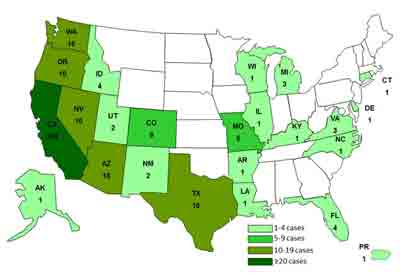Salmonella on Foster Farms chicken has sickened at least 416 people in 23 states, according to the latest update from the Centers for Disease Control and Prevention. The outbreak strains of Salmonella Heidelberg are resistant to several commonly prescribed antibiotics which may be a factor in the 40 percent hospitalization rate for this outbreak, which is about twice the average.
The company has not issued a recall for the chicken and despite its plans to improve in October conditions at three plants associated with the outbreak, reports of illness continued through the end of November and perhaps beyond, according to the CDC.
Although Foster Farms has not issued a recall, some retailers removed the chicken from store shelves following an October 7 health alert about the chicken issued by the U.S. Department of Agriculture’s Food Safety and Inspection Service (USDA-FSIS). The alert told consumers that reports of illness from Salmonella were associated with three Foster Farms facilities identified on packages with establishment numbers P6137, P6137A, and P7632.
The same day FSIS issued the health alert, it sent letters to Foster Farms threatening closure of the facilities because of conditions found at the plants including: fecal material on carcasses, poor sanitary dressing practices, insanitary food contact surfaces, insanitary non food contact surfaces and “direct product contamination.” Foster Farms submitted a plan to address the problems and, three days after it threatened closure, FSIS told Foster Farms the plants could stay open.
On October 12 and October 17, 2013, days after Foster Farms was told it could keep the plants open, Costco’s El Camino Real store in San Francisco recalled more than 23,000 Foster Farms rotisserie chicken products for possible Salmonella contamination after illnesses were reported.
Most of those who have become ill from the chicken, about 74 percent, are from California. Since the last update on November 19, 2013, a total of 27 new cases have been reported from 4 states: two from Arizona, twenty two from California, two from Colorado and one from Washington. By state the total number of cases is as follows: Alaska (1), Arkansas (1), Arizona (18), California (310), Colorado (9), Connecticut (1), Delaware (1), Florida (4), Idaho (4), Illinois (1), Kentucky (1), Louisiana (1), Michigan (3), Missouri (5), North Carolina (1), Nevada (10), New Mexico (2), Oregon (10), Puerto Rico (1), Texas (10), Utah (2), Virginia (3), Washington (16), and Wisconsin (1).
Another development since the CDC’s last update was the USDA’s release of its Salmonella Action Plan. The goal of the plan is to modernize poultry inspection by developing new performance and sampling standards, and creating enforcement strategies that link sanitary dressing problems to Salmonella issues. Many consumer advocates, including Food Poisoning Bulletin Publisher Fred Pritzker, don’t think the plan goes far enough.  A report released today from the Pew Charitable Trusts called “Weaknesses in FSIS’s Salmonella Regulation” uses the two Foster Farms Salmonella outbreaks this year to illustrate problems with poultry regulation and calls for a stronger response to these outbreaks.
A report released today from the Pew Charitable Trusts called “Weaknesses in FSIS’s Salmonella Regulation” uses the two Foster Farms Salmonella outbreaks this year to illustrate problems with poultry regulation and calls for a stronger response to these outbreaks.
Salmonella sickens 1.3 million Americans each year. Of those, about 15,000 are hospitalized and about 4,000 die. Salmonella infections can also trigger long-term health problems such as reactive arthritis, inflammation of the heart, spine, tendons and eye membranes. Direct medical costs associated with the treatment of Salmonella poisoning total about $1 million each day, according to the CDC.




